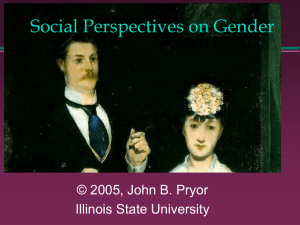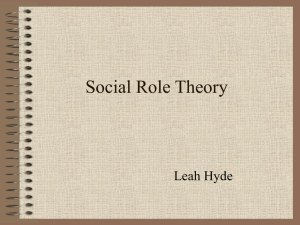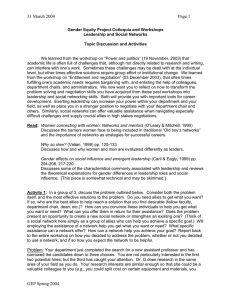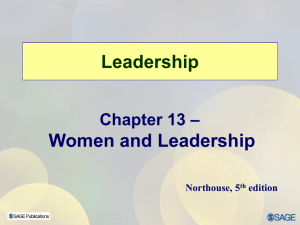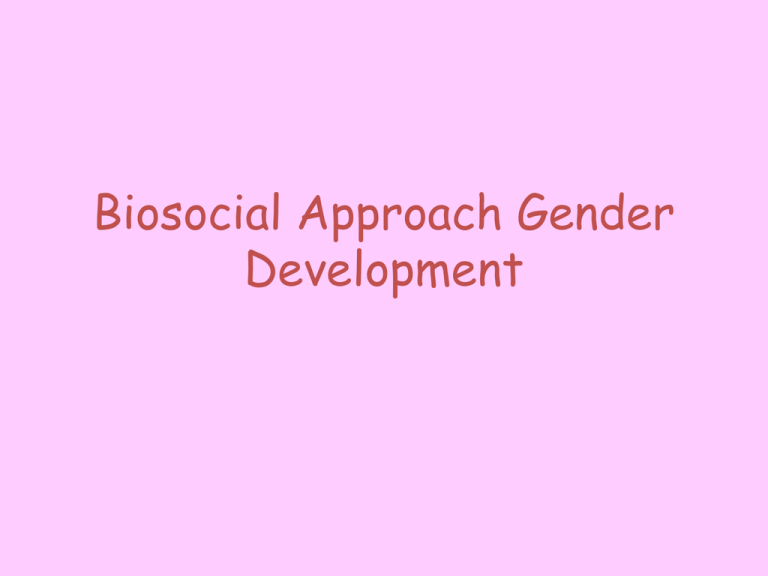
Biosocial Approach Gender
Development
Gender
Characteristics, whether biological or socially influenced, by which
people define male and female
•
•
•
•
• Women
Describe themselves in
more relational terms
Experience more
relationship-linked
emotions
More empathetic
Gravitate toward jobs that
reduce inequalities
• Men
• Focus on tasks and on
connections with large
groups
• Respond to stress with
“fight or flight” response
• Gravitate toward jobs that
enhance inequalities
Division of labour
Why are men seen as the “breadwinners”
or hunter gatherers?
Why are women often given the role of
homemaker and child minder?
Does our society today still benefit from
gender roles or is it becoming more
similar?
Exceptions
Agta Tribe
(Philippines)
Aka Tribe
(Africa)
Diana
Hunting
Goddess
Women during the Wars
•
•
•
•
•
•
•
•
•
•
•
Mechanics
Engineers
Tank drivers
Building ships
Working in factories making bombs and
aircraft parts
Air raid wardens
Driving fire engines
Plumbers
Ambulance drivers
WRVS volunteers
Nurses
Biosocial Theory
Parental expectations
Money and Ehrhardt (1972)
Social Role Theory
Eagly and Wood (1999)
What about sex differences in mate
choice?
• Resources
• Domestic
• Compliment
each other
• Gender and Mating Preferences
– Men seek out quantity
• Spreading genes widely
– Women seek out quality
• Protecting and nurturing of offspring
• Equal Pay
• Maternity cover
Hormonal differences
Are these differences a cause or an
outcome?
Eagly and Wood (2002) – hormonal
differences may be an outcome of social
roles e.g. testosterone as a result of
engaging in more active and competitive
activities
• Gender and Hormones
– Gender gap in aggression seems influenced by
testosterone
– As humans age they become more androgynous
• Mixing both masculine and feminine characteristics
Social Constructionist Approach
Eagly and Wood
Human behaviour is mainly
an invention or outcome
of a particular society
or culture
Behaviours are best
explained in the context
in which thy occur
Luxen (2007)
High ethical appeal if sex
roles are perceived as
more flexible
Buss (1989)
37 cultures examined
10,000 people
Women desire mates
with good financial
prospects
Men placed more
evidence on physical
attractiveness and
youth- fertility and
obedience
Both look for
intelligence, kindness
and loyal/dependable
(supports evolutionary)
Eagly & Wood (1999)
Used Gender
Empowerment Measure
When women had higher
status (more equal) –
mating preferences
become less pronounced
Therefore social roles
are driving force in
psychological sex
differences
However, Gangestad et al (2006)
Re-examined same data
Gender equality not related to sex
differences.
Therefore evolutionary theory better
explanation
Culture
• Gender Role
•Set of behavior
expectations (norms) for
males and females
•Gender roles vary over
culture
•Gender roles vary over
time
• Peer-Transmitted
Culture
– 50 percent of individual
variations in personality
traits is by parental
nurturing
– The other 50 percent is
peer influence


